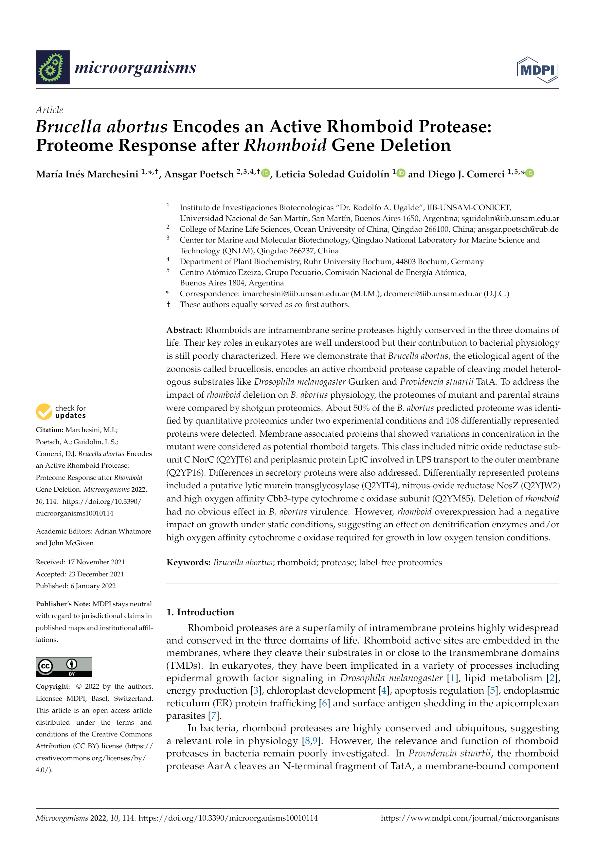Artículo
Brucella abortus Encodes an Active Rhomboid Protease: Proteome Response after Rhomboid Gene Deletion
Fecha de publicación:
06/2022
Editorial:
MDPI
Revista:
Microorganisms
ISSN:
2076-2607
Idioma:
Inglés
Tipo de recurso:
Artículo publicado
Clasificación temática:
Resumen
Rhomboids are intramembrane serine proteases highly conserved in the three domains of life. Their key roles in eukaryotes are well understood but their contribution to bacterial physiology is still poorly characterized. Here we demonstrate that Brucella abortus, the etiological agent of the zoonosis called brucellosis, encodes an active rhomboid protease capable of cleaving model heterologous substrates like Drosophila melanogaster Gurken and Providencia stuartii TatA. To address the impact of rhomboid deletion on B. abortus physiology, the proteomes of mutant and parental strains were compared by shotgun proteomics. About 50% of the B. abortus predicted proteome was identified by quantitative proteomics under two experimental conditions and 108 differentially represented proteins were detected. Membrane associated proteins that showed variations in concentration in the mutant were considered as potential rhomboid targets. This class included nitric oxide reductase sub-unit C NorC (Q2YJT6) and periplasmic protein LptC involved in LPS transport to the outer membrane (Q2YP16). Differences in secretory proteins were also addressed. Differentially represented proteins included a putative lytic murein transglycosylase (Q2YIT4), nitrous-oxide reductase NosZ (Q2YJW2) and high oxygen affinity Cbb3-type cytochrome c oxidase subunit (Q2YM85). Deletion of rhomboid had no obvious effect in B. abortus virulence. However, rhomboid overexpression had a negative impact on growth under static conditions, suggesting an effect on denitrification enzymes and/or high oxygen affinity cytochrome c oxidase required for growth in low oxygen tension conditions.
Palabras clave:
BRUCELLA ABORTUS
,
LABEL-FREE PROTEOMICS
,
PROTEASE
,
RHOMBOID
Archivos asociados
Licencia
Identificadores
Colecciones
Articulos (IIBIO)
Articulos de INSTITUTO DE INVESTIGACIONES BIOTECNOLOGICAS
Articulos de INSTITUTO DE INVESTIGACIONES BIOTECNOLOGICAS
Citación
Marchesini, Maria Ines; Poetsch, Ansgar; Guidolin, Leticia Soledad; Comerci, Diego José; Brucella abortus Encodes an Active Rhomboid Protease: Proteome Response after Rhomboid Gene Deletion; MDPI; Microorganisms; 10; 1; 6-2022; 1-20
Compartir
Altmétricas




